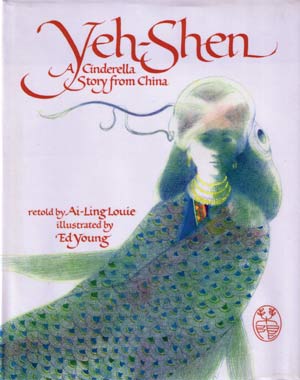
Title: Lon Po Po
Publisher and Date: Penguin Putnam Books for Young Readers, 1989
Genre: Picture Book, Traditional Tale
Age Range:1st-3rd
1990 Caldecott Medal Winner
Summary:
In this very different tale of little red riding hood, the mother travels to the grandmother’s (Po Po) house and leaves her three children at home. The three girl’s names are Shang, Tao, and Paotze. She warns her children before she goes, “Remember to close the door tight at sunset and latch it well.” The crafty wolf observes her leaving and comes up with a plan to trick the children into being his dinner. He waits until dark and then knocks on the door acting like he is their Po Po. The children question him, but eventually decide to let him in. They began to realize that something isn’t quite right with their Po Po. Shang observes, “Po Po Po Po your foot has a bush on it”, when she brushes the wolf’s tail. Shang, the eldest, finally realizes what’s happening and comes up with a clever plan of her on. She lures the wolf outside with promises of a famous
gingko nut that “is soft and tender, like the skin of a baby. One taste and you will live forever.” The children trick the wolf into letting them pull him up the tree in a basket so that he too can reach the gingko nuts. When the wolf is close to the top branch, the children let the basket go and the wolf falls to his death. The children go back inside to sleep safe and sound until their mother returns.
Response: Lon Po Po is a much different version of little red riding hood. This version seemed to be a lot darker then the previous versions I had read. The inscription to the wolves on the very first page adds to this dark effect. Young thanks the wolves for allowing us to use them as our symbol of "human darkness." The illustrations also add tremendously to this dark atmosphere. Young's illustrations are done with watercolors that have been smudged to give each illustration a smoky, surreal effect. Most of the illustrations from inside the house are dark and blurry; you cannot really see what is going on clearly in any of the pictures. I think this definitely helps to give the reader a sense of suspense and dread. To me the scariest picture in the story is of the wolf lying in bed. You can only see his yellow eye staring out and the outline of his teeth. If I was a young child I would be scared to death! In most cultures, especially the Chinese culture, folktales are told to teach a lesson or moral. This story I think could have several lessons to impart to readers. The first lesson is to always listen to your elders. Their mother warned them specifically before she left to latch the door at sunset. If they had listened to her and not let anyone in the house then they would have been safe. The second lesson that I pulled from the story was that selfishness and greed never pay off. The wolf had the children literally trapped, yet he allowed them to escape because of his greed for something more (the gingko nuts). His greed also led to his death. This is a great lesson for us all. Selfishness and greed never pay off! In the end they only lead to ruin and despair.
Teaching Ideas:
This book would also be a great book to do a compare and contrast activity on. This book is much different from any book I have ever read about little red riding hood. I think it would also be neat to discuss the Chinese culture along with this book and how it played an integral role in the story! This is a very interesting read! Be sure to check it out!









